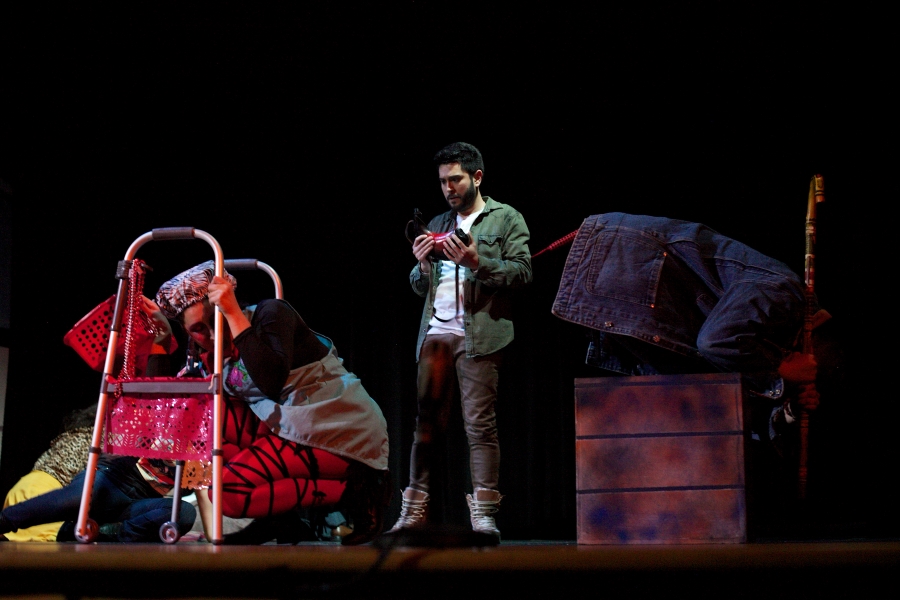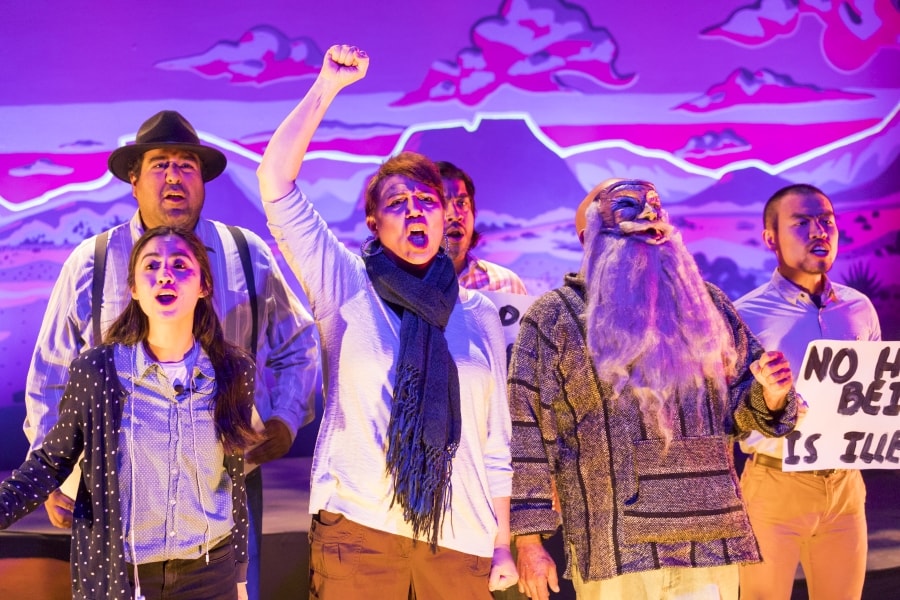La Pastorela is the ultimate theatre for young audience (TYA) experience: a classic story, topical subject matter, audience participation, and music, with a holiday tie-in to boot. Not bad for a tradition that’s almost 500 years old.
“The idea that TYA is really for all ages is treated like a new idea, but Mexican American and Latin American communities have been doing it for a really long time,” says Roxanne Schroeder-Arce, director of UTeach Fine Arts and associate professor of Theatre Education at University of Texas-Austin. “Pastorelas have been engaging young people for years before our field even began.”
First performed in the Americas at least as early as 1526, La Pastorela is a retelling of the Nativity story. While every production is different, most follow a group of shepherds traveling to meet the baby Jesus. Along the way, the devil tries to thwart the shepherds’ plans while angels intervene to help.
“It’s a classic struggle between good and evil,” says Marie Acosta, artistic/executive director of the Latino Center of Art and Culture (LCAC) in Sacramento, Calif., where the sixth annual La Pastorela de Sacramento will run Dec. 13-16. “And in the times we live in, it’s a superb way to talk about what’s going on.”
Pastorelas were originally used as a tool by the Spanish to convert Native populations to Christianity. But over time Latinx communities in the U.S. and Mexico have used the form as a means for civic engagement, reflection on current events, and in some cases, reconnecting with Indigenous cultures.
“It’s something that was used as a way to colonize and Christianize, and at some point it became a national symbol for Mexico,” Christy Sandoval, director of El Teatro Campesino’s 2017 La Pastorela, said in an interview with Monterey County Weekly last year. “They’re trying to find the positives amid a tumultuous history for Chicanos and Latinos across the Americas.”
Founded by Luis Valdez in 1965, El Teatro Campesino has built an international reputation by using theatre to advocate for California farm workers and speak to the Chicana/o experience. The company has presented a pastorela every other year since 1975, alternating with productions of another holiday story, La Virgen del Tepeyac (now running through Dec. 16 at Old Mission San Juan Bautista in San Juan Bautista, Calif.). In 1991, El Teatro Campesino’s La Pastorela was televised on PBS Great Performances, starring Linda Ronstadt as the archangel San Miguel.
Scholar Robert Potter argues that El Teatro Campesino’s La Pastorela offers crucial commentary on the immigrant experience, writing in an article for Comparative Drama titled “The Illegal Immigration of Medieval Drama to California,” that “the contemporary California revival of the pastorela is not so much a resurgence of the old California tradition as it is a legacy of the cultural possessions brought by more recent waves of immigrants from Mexico, many of them illegal. From this point of view, the procession of the shepherds retraces the path of the [immigrants] who crossed the Rio Grande to find themselves strangers in a strange land, huddling together for warmth and support.”
In contemporary pastorelas, the story is often updated to speak to issues of the moment, which now include immigration-related concerns. In LCAC’s upcoming La Pastorela de Sacramento, written by Acosta and Tomas Benitez, the shepherds are a gentrifying real-estate developer, an actor, an Afghan War vet, and an activist. In Teatro Vivo’s La Pastorela in Austin last year, the shepherds were a group of DREAMers.
“There were a lot of moments where the piece was speaking to the national immigration crisis, but also very much to the specific,” says Schroeder-Arce, who is a board member of Teatro Vivo. “The production was helping people in Austin understand what’s happening here, what our resources are, and the ways that we can impact the immigrant community in Austin.”
In addition to tackling serious subject matter, pastorelas employ a number of techniques to keep audiences of all ages engaged. LCAC’s pastorela includes a bilingual choir and a local dance group, as well as topical jokes, like a devil in a red hat that reads “Make Heaven Great Again.”
“The music and the visuals really attract the children, as well as the physicality of the show, and the political commentary and humor engage adult audiences,” says Acosta. At Teatro Vivo’s pastorela last year, children brought canned goods to the production and at one moment in the show, went on stage and gave them as gifts to the baby Jesus.
“There’s less concern about everyone understanding everything,” says Schroeder-Arce. “Rather, there’s something that draws everyone in. Children and adults going to the theatre together is just part of the sensibility. Children are introduced to the theatre early, and no one’s offended or frustrated if a baby cries. That’s a critical piece of the tradition.”

This spirit of inclusion extends to casting as well. The cast of LCAC’s pastorela is made up of children, teens, local actors, and other community members. “Sacramento isn’t known as a great theatre town, but it’s growing, and we now have a lot of wonderful talent,” says Acosta. For their part Austin’s Teatro Vivo tries to cast everyone who auditions for their pastorela. “There’s a tradition of giving everyone an opportunity who wants an opportunity to be a part of this event,” says Schroeder-Arce.
While the size and production values of pastorelas can vary, most reach their audiences primarily through word of mouth and other grassroots methods. “People see it every year, and just know to come back because they want to see what’s changed,” says Schroeder-Arce. “The marketing is different, and it’s not advertised as much.”
LCAC advertises through traditional methods, including working with a Spanish-language television station, but also relies heavily on community outreach and social media. “We’re starting to see the results of our efforts, a holiday tradition in Sacramento rooted in Latino culture,” says Acosta. “We target our audience and they know who we are. Most of our audience is Latino, though we also get a lot of people who are interested in the themes, in musical theatre, or in having a cultural experience.”
Pastorelas can blur the lines between performer and audience member, theatre and community event, ritual and entertainment. While the form’s ability to negotiate so many different worlds is part of its appeal, its hybrid and democratic nature can also cause theatregoers to label it as folk performance or community theatre, as opposed to acknowledging it as a unique and complex theatrical form.
“Teachers will ask students, ‘What theatre do you know?’” says Schroeder-Arce. “A lot of Mexican children may have seen a pastorela, but the teacher may not recognize it as a valid form of theatre. So an important part of this conversation is the lens from which we look at any particular kind of performance, and what gets to be considered ‘legitimate.’”
Pastorelas may still have to fight for a place in the canon, but in a year when the U.S. government has been especially cruel to Latinx children and families, La Pastorela can demonstrate the power of culture and community to incite positive social change. “Hopefully, it inspires dialogue, both about the word today, and how we can all support each other and make the world better—together,” says Schroeder-Arce.


